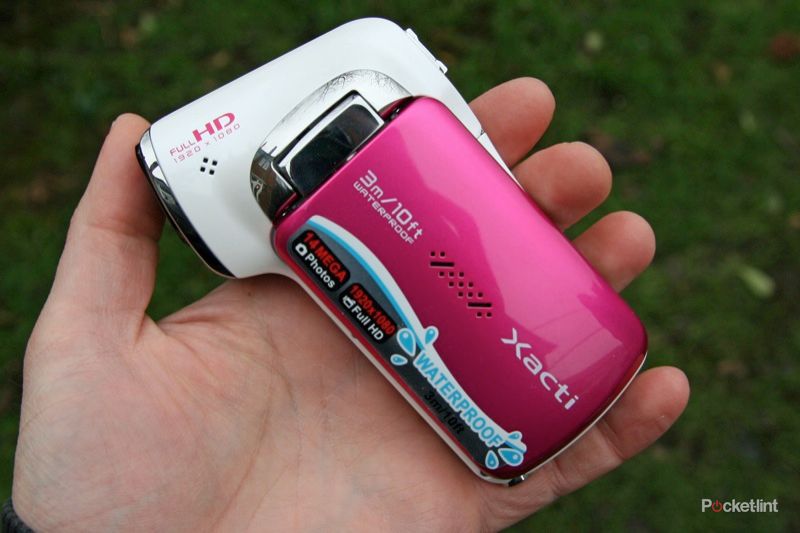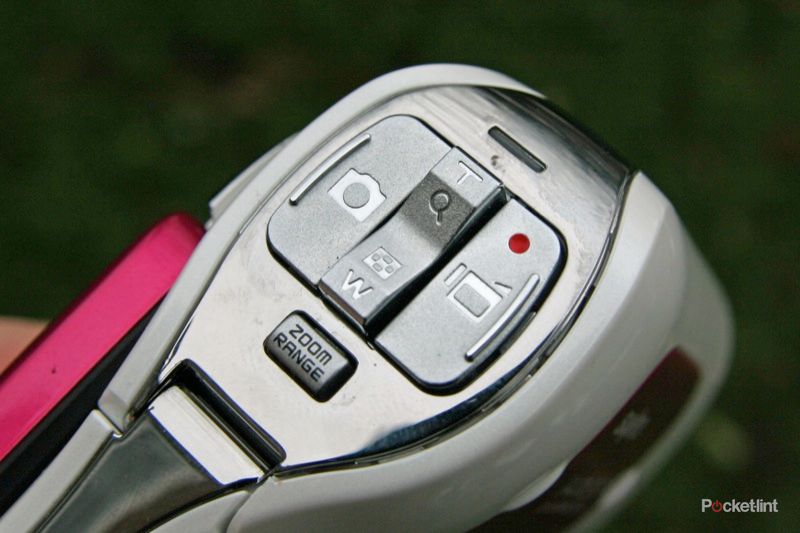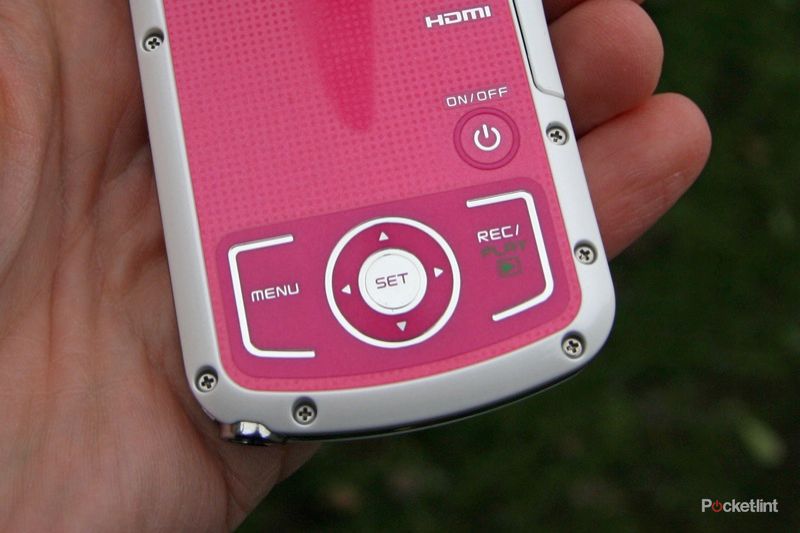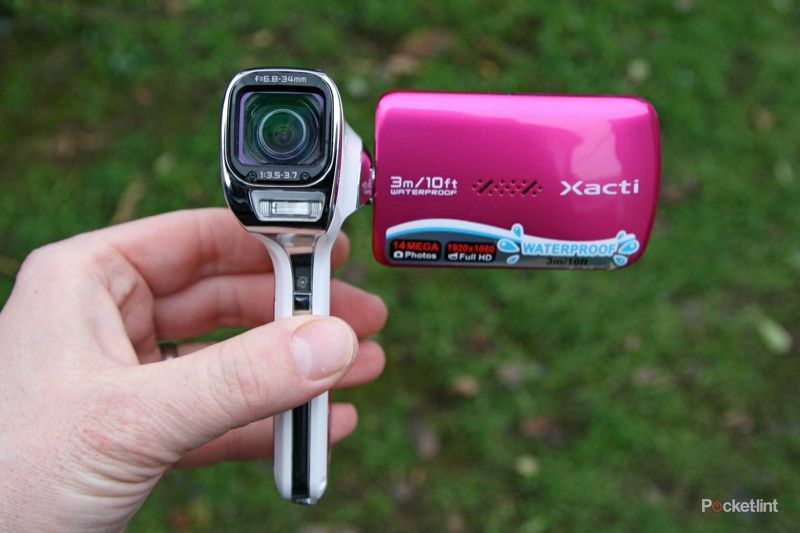The Sanyo Xacti VPC-CA100 is a waterproof “dual camera” as Sanyo puts it. Using the pistol grip form factor, it is called a dual camera because it claims to offer not only Full HD video capture traditionally associated with this sort of design, but also respectable still image capture, thanks to its 14-megapixel CMOS sensor.
Our quick take
We’re not entirely sold on the “dual camera” billing. Although the CA100 is capable of a range of more advanced features above just capturing a simple still image, in practical use it is a little too fiddly to use unless you really have to have that shot. Compared with a compact camera, you’ll probably find yourself wanting more for stright photography, but the form factor makes it better for video than your average compact.
Great looking sharp footage with plenty of detail and realistic colours, it isn’t the best shooter in low light, but you can’t have everything. The RRP of £349 does make it looks a little more expensive than it perhaps should be, but it is widely available at over £100 less, where it looks more appealing.
Overall we’re impressed with the Sanyo Xacti CA100. The convenience of waterproofing in a compact package will appeal to those who are a little more adventurous and the pistol grip design makes for easy shooting.

Sanyo Xacti VPC-CA100 - 4.0 / 5
| FOR | AGAINST |
|---|---|
|
|
The CA100 is fairly lightweight for a camcorder at 242g, but the weight and dimensions can’t compete with compact camera that now offer similar capture opportunities. Whereas you’ll be able to slip the latest Canon IXUS into your pocket, the Xacti is more troublesome. That said, the pistol grip form factor does make it more positive to shoot video with, it is easier to keep stable whilst handheld and you get a flip-out screen, which smaller compact cameras won’t offer you.
The display folds flat down the “grip” of the device, covering a selection of the controls. On the rear of the grip is a locking flap offering up a Micro-USB and mini HDMI connectors, the former allowing for connection to your PC or charging the battery, the latter letting you hook-up to a display. Internally the grip houses the SD card and battery, both accessed by removing a locking flap. Given this camcorder’s waterproof claims, you’ll find things lock down nice and tight.
On the rear are a selection of controls that fall under the thumb offering both still and video capture, zoom and a “zoom range” button. The latter is a live button that switches between “wide” and “tele” modes whilst filming, meaning you can instantly jump closer to a subject with a single press. Effectively it means you can switch between 40-240 mm wide and 80-480mm tele modes.
The zoom range feature works by changing the sensor area in use whilst filming. It is an almost instantaneous, a slight pause as it moves in, but it keeps focus, which we found useful – in some instances the CA100 takes a little time to resolve focus and using the manual zoom in the same circumstances left us with a blurry picture for a while. It is sensitive button and placed a little too close to the zoom controls, so you might find you press it accidentally.
Lifting the screen powers the CA100 on. The screen can then be swivelled to give you a range of shooting options meaning high or low angle shots are easily captured. The placement of the controls isn’t the best, but given the design, most will probably find it is an acceptable layout. The rear cluster are perhaps a little too tight, meaning you need to make a very definite stab for the feature you want, and the action is a little too indistinct, especially when it comes to still image capture. The menu navigation is handled by controls on the inside face of the handgrip.
Navigating the menus is via the fairly small four-way controller with central “set” button. As these aren’t facing you, it does take a little of time to get used to. It isn’t exactly speedy to change things on the fly, although you can switch to a simple menu that only offers resolution, focus mode and flash control if you prefer. You’ll need to use the menus to take advantage of some of the features of the CA100, because as we’ve already mentioned, in terms of physical buttons you get zoom and record and that’s it.
Lurking in the full menu you’ll find controls for the digital stabilisation, the metering, focusing, ISO (auto to 1600), white balance, exposure mode, target tracking, digital zoom and so on. There are a wealth of options dealing with both stills and video, and you can dive in and find the likes of aperture and shutter priority modes, but it is neither obvious or easily accessed.
So viewed as a compact camera alternative, it does sort of fall down when it comes to stills shooting, although we suspect that it won’t be a replacement for a camera, rather an opportunistic alternative. The provision of a Xenon flash does mean that you can grab a low light shots as you would on a regular camera, which some camcorders wouldn’t offer you. Of course, you don’t then get an LED illuminator, so in low light you’re left with whatever the sensor can interpret.
Stills suffer from the rather indistinct button action. Pressing the button switches from the video mode to stills capture, followed by focusing and finally grabbing the shot. Like a regular camera, a half press should take you all the way up to focusing, but as we’ve said, the action is so sloppy it becomes a little hit and miss.
The stills results aren't anything to get excited about, but will give you a good return in good conditions. The flash directly under the lens results in a good deal of red-eye, but gives better results than LED alternatives. There is a noticeable delay in the capture process when using the flash. However, the CA100 is aware of things like shutter, ISO and aperture, so if a shot is crucial, you can take control and get a better result, if you have the patience.
Taken as a camcorder first and foremost, the simplicity of controls makes much more sense. You can pretty much just point and shoot once you’ve sorted through the menus and decided what you want your settings to be. The electronic stabilisation seems effective, with hand-held walking shots not encountering the sort of wobble that smaller models suffer from, so is worth playing around with.
The stereo mics are placed on the front of the display, far enough away from the working parts to avoid capturing zoom or focusing noise. A wind reduction option is available as its exposed position is prone to environmental noise, and it is surprisingly sensitive. There is no option for an external mic and we did find that all video had a level of hiss and that the mic and easily pick up hand noises if you are adjusting your grip or altering the screen angle.
Focusing seems to be one of weaknesses. Although the CA100 will often find a target and stick to it, there is the occasional pulse as it confirms focus. Zooming, especially in lower light can see focus lost, and the Xacti flounders for a while before it figures out where it is supposed to be. Used slowly and deliberately, however, it is much less of a problem.
Low light capture isn’t great and you’ll find noise appearing in shadows indoors, with more noise crashing in as things get darker. The same applies to still capture.
The Sanyo Xacti CA100 offers up a wide range of resolutions and frame rates, from the top setting of 1920 x 1080 60fps (16Mbps), down to 30fps (12Mbps) and 60 (12Mbps) or 30fps (9Mbps) at 720, with an additional 640 x 480 30fps (3Mbps) setting. The results are good, with the HD settings delivering the detail you’d expect, and a result that looks good played back directly on a large screen.
The other ace up the CA100’s sleeve is the waterproofing. It is certified to IPX8 standards, meaning it is suitable for continued submersion in water, with Sanyo citing a depth of 3 metres. We didn’t test it underwater (other than an exploratory dunk) but we did have it out in the snow where it got wet – not that it cared. Aimed at those hitting the beach or slopes, it means you don’t have to worry about ruining your video camera should it start raining, or you drop it.
There is no lens cover so you need to ensure that you protect the CA100 in storage and transit. Although the glass is recessed in the housing, it wouldn’t take much to scratch it. The screen is bright enough, but the resolution isn't always sharp enough to determine that you have your subject perfectly in focus. Sometimes we found it settled on an adjacent subject, especially in close-ups.
The battery is good for about 60 mins of full HD video capture, which sounds a little on the short side, especially if this is your sole camera and you are taking it out for a full day, although you could buy an additional battery and simply swap them over. It will alternatively offer you 200 still shots.
To recap
Overall we’re impressed with the Sanyo Xacti CA100. The convenience of waterproofing in a compact package will appeal to those who are a little more adventurous and the pistol grip design makes for easy video shooting




